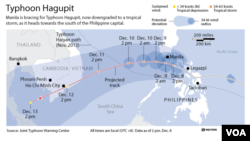The Philippine capital is bracing for a weakening Typhoon Hagupit, which caused widespread destruction and killed at least 23 after coming ashore on the eastern island of Samar.
Red Cross Secretary-General Gwendolyn Pang said Monday that at least 18 of the victims died on the eastern island of Samar where Typhoon Hagupit made landfall late Saturday, tearing off roofs of buildings and knocking out power in entire coastal provinces.
The latest death toll came as the capital, Manila, braced for the arrival of the storm Tuesday as it continues to slowly move through the Philippines. Hagupit made landfall Monday evening on the resort town of San Juan in Batangas province, about 100 kilometers (60 miles) south of the Philippine capital.
In the capital region, several thousand people have moved to evacuation centers.
But in Manila, a few holdouts along Manila Bay plan to stay put. Forecasters warn of high waves, especially during high tide Monday night.
Roxas Boulevard, located along the bay, turns into a virtual river during heavy storms. Still, Remedios Tayag and her neighbors, all of whom were taking shelter from light rain under two tarpaulin sheets on the sidewalk, said they are not going to a shelter.
Tayag said, “There’s nothing we can do. ... It rains every year.”
Schools have been suspended, the stock market is closed, many office and government workers have been told to stay at home, and dozens of commercial flights have been canceled.
Now a tropical storm
The storm further weakened Monday and was downgraded from a typhoon to a tropical storm.
Forecasters said Hagupit, which was moving northwesterly at about 10 kilometers per hour, may take three days to cross the central Philippines.
Authorities said Hagupit does not appear as destructive as last year's Typhoon Haiyan, in part because of a massive operation that evacuated nearly 1 million people from coastal and landslide-prone areas.
However, officials said they are worried by the storm's heavy rains, which could still possibly trigger landslides and flash floods.
Typhoon Haiyan killed more than 7,300 people and brought some of the strongest winds ever recorded on land.
Thousands of victims of Haiyan are still living in tents, a year after it took roughly the same path as the current typhoon. There were reports that some temporary shelters that were housing people displaced by the super typhoon were destroyed.
Aid agencies said damage by the storm and continued rough seas are hampering efforts to reach stranded residents in far-flung areas.
Philippine Red Cross Disaster Manager Roderic Salve said teams are clearing debris as they push toward an Eastern Visayas town that is close to where Hagupit first made landfall.
Salve said rough seas are keeping a supply ship from entering waters surrounding the Samar provinces, where Catarman and tiny remote islands are located. There are reports houses on those islands were nearly all destroyed.
Damages
In an early assessment, the Philippine Red Cross said Hagupit damaged 980 houses.
A Philippine Navy spokeswoman said several ships bearing relief supplies are ready to go to the Eastern Visayas. But they have to wait for the weather to clear.
However, life returned to normal Monday in Cebu City. Hagupit moved past this region of the central Philippines and there have been no reports of significant flooding or wind damage.
The City Central School, which was converted into an evacuation shelter during the storm, is being cleaned. School principal Lyra Illaga said classes for the more than 4,000 students will resume very soon.
Some areas in Northern Cebu and in the eastern Philippines were hit hard by the storm. There are reports that some houses and power lines were torn down by the strong winds.
The Red Cross has dispatched assessment teams to these areas.
Brian Padden contributed to this report from Cebu. Simone Orendain contributed to this report from Manila. Some material for this report came from Reuters, AFP and AP.













